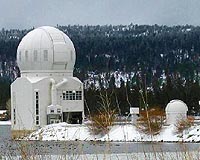 |
by Yu Zheng, Wang Aihua Xinhua science writers Beijing (XNA) Jun 08, 2009 China built the finest optical telescope to scan 10 million celestial spectra in the coming five-to-six years, one of the world's most ambitious astronomical endeavors to record key data betraying how the universe was formed. The Chinese government, which awarded the 235 million-yuan (34 million U.S. dollars) contract to a consortium of elite astronomers and engineers, officially unveiled Thursday the Large Sky Area Multi-Object Fiber Spectroscopic Telescope (LAMOST), the biggest telescope of its kind in the world. The research team, led by Cui Xiangqun, a world-renowned active optics expert who heads the Nanjing Institute of Astronomical Optics and Technology under the Chinese Academy of Sciences (CAS), made a breakthrough in synchronized movements of 24 hexagonal mirrors of a Schmidt reflecting corrector, which is used to track celestial bodies for scientific analyses. Cui and her team even made each mirror piece, 1.1 meters in diametrical length, capable of deformation for more precise targeting and error correction in observations. Light from celestial bodies are reflected to a bigger spherical mirror, made up of 37 same-sized hexagonal mirrors in a similar way. With the 3.6-meter-aperture reflector and the 4.9-meter-aperture spherical mirror, together with a focal plane mounted with 4,000 optical fibers, all cutting-edge technologies, scientists, could ascertain spectra of 2.5 million fixed stars, 2.5 million galaxies, 1.5 million brighter cluster galaxies and one million quasi-stellar objects, mostly in the north celestial sphere. All the 10 million spectra are expected to be completed within five-to-six years, Cui said, adding that the data would be subsequently accessible to global scientists. Spectra are key for astronomers to read celestial bodies' chemical composition, density, atmosphere and magnetism. So far, the science community have found the existence of billions of celestial bodies, but have only managed to collect spectra of about one in every 10,000 of them. The ambitious goal of collecting so much data encouraged Cui and her team to overcome the obstacles making a super large telescope that has both a big aperture and wide field of view. Inspired by her mentor Su Dingqiang, a leading Chinese astronomer who is also a prestigious CAS member, the 58-year-old Cui combined a 15-story-high scope, missile silo-like observatory tower on top of a 960-meter hill 170 kilometers northeast of Beijing. During observation nights, the upper parts of the lower dome are removed and starlight is reflected from the mirror up through the 40-meter tube to the primary mirror. The light of space is fed into the front ends of optical fibers positioned on a focal plane, before real-time data are recorded into spectrographs fixed in a room underneath. The idea was developed from the spherical and aspherical mirror combination, invented by German opticist B. V. Schmidt in 1931. It also uses advanced active optics technologies. Dr. R. N. Wilson, inventor of the active optics theory, wrote in an e-mail to Cui, his former colleague at the European Southern Observatory, that LAMOST "embodies every aspect of the most advanced and modern telescope technology." Continuing mankind's dream of understanding the universe, triggered by the invention of astronomical telescope by Italy's Galileo Galilei, Chinese scientists are hoping to capitalize on the "costly big toy" to unravel dark matter, dark energy, as well as celestial formation and evolution. Before LAMOST, the American Sloan Digital Sky Survey (SDSS) had been the most powerful spectra-collecting optical telescope. Installed in a New Mexican astronomical station, SDSS has an aperture of 2.5 meters. In recent months, Cui's huge telescope managed to capture more than 3,600 spectra in each of the four trials on clear Spring nights. "We're quite comfortable with the scans," Cui said. "Most of the time, we shot the targets exactly, if not hitting the bull's eyes." University of Chicago Prof. Donald York, founding director of SDSS, said in an e-mail interview with Xinhua that the data for well-positioned fibers of LAMOST looked "very good." York, however, said that precise calibrated data in wavelength and absolute flux of the celestial bodies cannot be done until the telescope's fiber positioning becomes "perfect" after debugging. California Institute of Technology astronomer Richard Ellis said, "A large telescope is one of the best examples of what a civilization does well, and I think here we look at the LAMOST now and we see what China has done." Cui said Chinese scientists might consider building a similar big telescope on Antarctica, to gain wider and clearer cosmic view.
Source: Xinhua News Agency Share This Article With Planet Earth
Related Links (Xinhua/Wang Yongji) Space Telescope News and Technology at Skynightly.com
 World's Largest Solar Telescope Open For Business
World's Largest Solar Telescope Open For BusinessBig Bear Lake CA (SPX) Jun 01, 2009 NJIT's new 1.6-meter clear aperture solar telescope - the largest of its kind in the world - is now operational. The unveiling of this remarkable instrument - said to be the pathfinder for all future, large ground-based telescopes - could not have come at a more auspicious moment for science. This year marks the 400th anniversary of Galileo's telescope that he used to demonstrate that suns ... read more |
|
| The content herein, unless otherwise known to be public domain, are Copyright 1995-2009 - SpaceDaily. AFP and UPI Wire Stories are copyright Agence France-Presse and United Press International. ESA Portal Reports are copyright European Space Agency. All NASA sourced material is public domain. Additional copyrights may apply in whole or part to other bona fide parties. Advertising does not imply endorsement,agreement or approval of any opinions, statements or information provided by SpaceDaily on any Web page published or hosted by SpaceDaily. Privacy Statement |